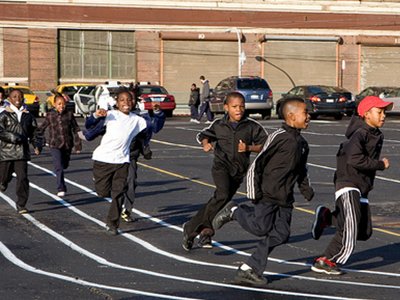Open Gym
Is your school looking for ways to increase physical activity before or after school? Consider hosting open gym!
Read More Many communities lack spaces and equipment for physical activity. Additionally, many neighborhoods may not have sidewalks or open spaces, such as parks, that facilitate regular physical activity. In other communities, existing outdoor space may be unsafe or unsupervised. Opening facilities outside of school hours can provide a safe and familiar place for students and their families to be active! This can be done by creating a joint use agreement with a partner organization or by simply extending the hours of the school day to allow students and their families to be physically active.
Many communities lack spaces and equipment for physical activity. Additionally, many neighborhoods may not have sidewalks or open spaces, such as parks, that facilitate regular physical activity. In other communities, existing outdoor space may be unsafe or unsupervised. Opening facilities outside of school hours can provide a safe and familiar place for students and their families to be active! This can be done by creating a joint use agreement with a partner organization or by simply extending the hours of the school day to allow students and their families to be physically active.
Public school buildings are places that can and should play an important part in increasing physical activity, not only among the students, but also for families and community members, too. Take action with some of these strategies.
Joint use refers to two or more groups, usually a school and a city or private organization, sharing indoor and outdoor spaces like gymnasiums, athletic fields and playgrounds. The rationale is clear: Share resources to keep costs down for everyone and communities healthy. Joint use is a way to increase opportunities for children and adults to be more physically active.
Examples of joint use agreements:
Joint use agreements make physical activity easier by providing kids and adults with safe, conveniently located and inviting places to exercise and play. As a parent or in cooperation with the school wellness committee, explore the steps needed to gain access to facilities during non-school hours.
Create a schedule for parents and volunteers to sign up and act as supervisors during open facility hours to help keep students safe. Encourage parents and community members to participate in the fun!
In addition to having a sign-up sheet for parents and volunteers, consider having one for students as well. By knowing how many students are attending, you will be able to plan for the correct number of adults to supervise.
Remember to highlight the benefits of open facilities while talking with your school administrators, school boards, and insurance agents. Open facilities can keep children safe with nurturing supervision and provide opportunities to reinforce learning from school.
Keep the hours of your open facility convenient for parents, as well as students, especially during work hours and holidays.
Consider finding sponsors to help with the expenses of keep the facilities open for longer than normal. Ask local organizations or for-profit businesses to help fund the program.
Allow “third-party” organizations (such as YMCAs or Boys & Girls Clubs) to use indoor and outdoor facilities after school hours to help operate programs.
Attend a PTA meeting and ask participants if they are concerned about physical activity space in their community.
Build a list of the individuals who are interested in opening the school facility to the community to demonstrate support.
Continually document community testimony around the need for physical activity spaces to secure support for this cause.
Be sure that the messages about access to facilities for physical activity reach students with disabilities and special needs. The programs and activities at public facilities should be inclusive of all interested students in the community with accommodations for their participation as needed. Information about opportunities to use the school facilities should be disseminated to the entire community through local media outlets, school website, school newsletter, and at public meetings of PTA. Such notifications should describe what facilities are available and accommodations for special needs, schedules, and rules for use.
Categories: Physical Activity & Play, At School, Digital Resource